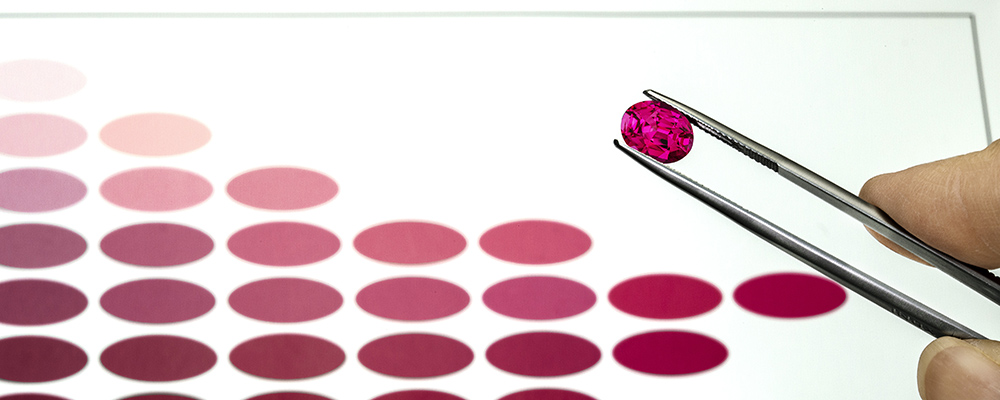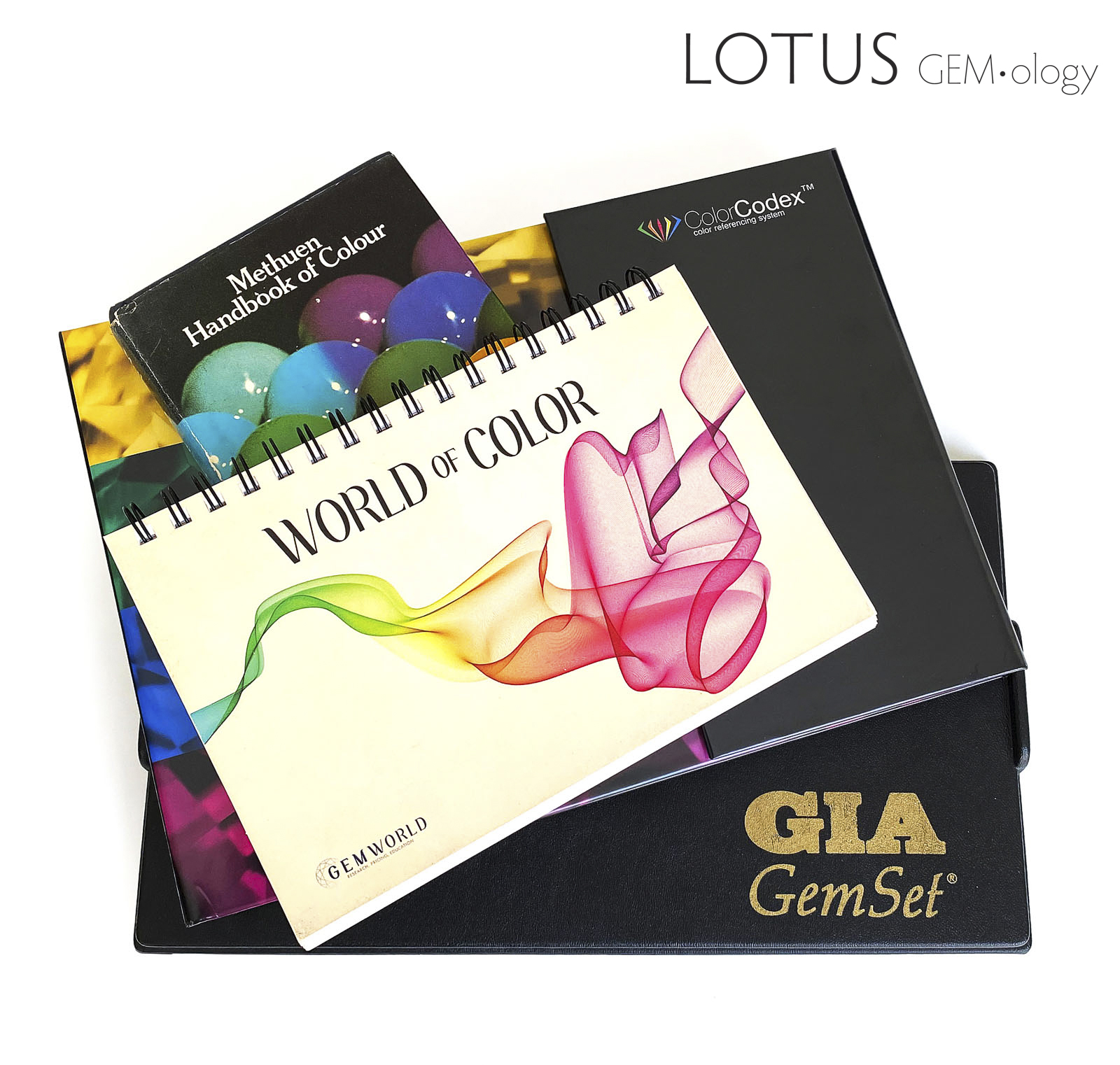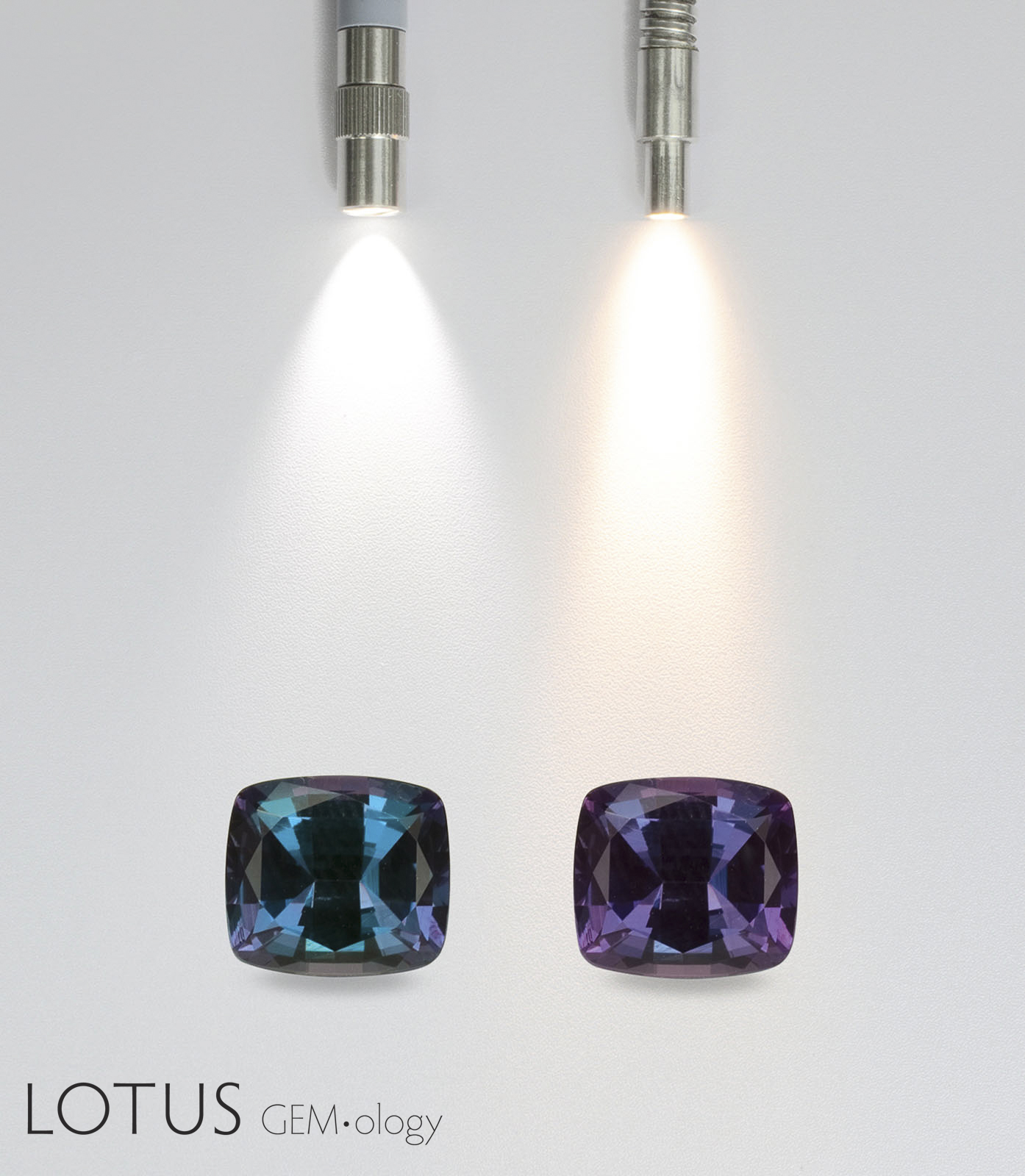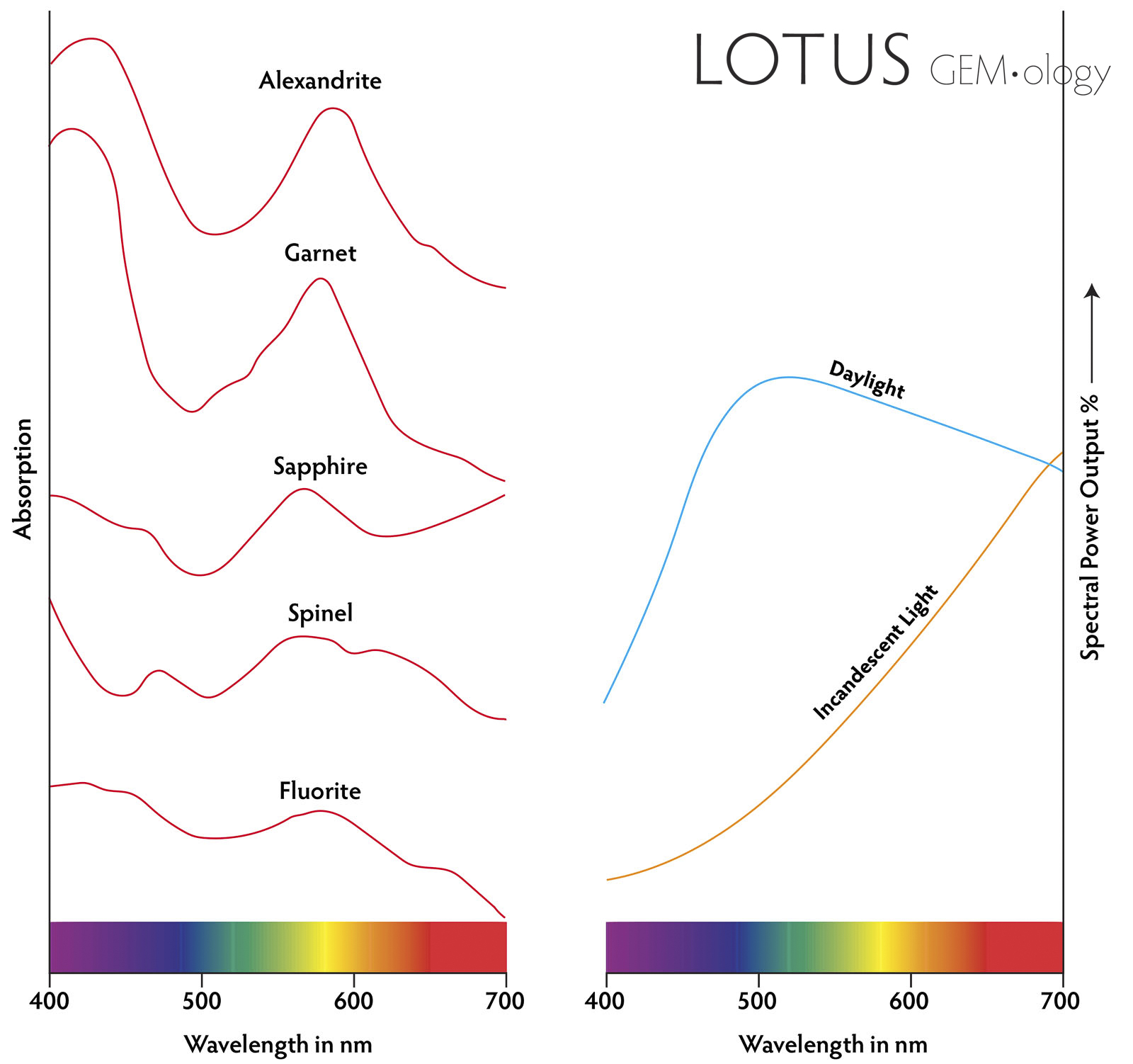Color types such as "pigeon's blood," "Paraíba" and "cobalt blue" have become wildly popular in the gem trade. But there is a vast difference between coining such terms and applying them in a way that is both consistent and logical. Richard Hughes casts a critical eye on the subject.
What is the finest blue, or the finest red?
In truth, there is no finest color; that is a personal preference for each of us. But on social media, there is no shortage of pundits pontificating on the “proper” color description of a gem, even when they have only seen a photo of a photo of it. How’s that for paranormal?
I have occasionally had the opportunity to participate in such discussions. The following is a near-verbatim sample:
Facebook Expert: Look at this so-called “padparadscha” (posting a crooked photo of a pic of a pic from a lab report). That’s no pad. It’s not even close!
Me: It’s tough to say if you haven’t seen the stone. Describing color is difficult.
FB Expert: Fool! Why can’t you gemologists just use a Pantone color book.[1][1] Pantone will be discussed later in the article.
What follows is an essay on some of the complexities of color as they apply to faceted colored gemstones, a fool’s guide, if you will.
POSITIVELY PARAÍBA
In 1982, Heitor Dimas Barbosa noticed some vivid blue grains in samples of pegmatite ore shown to him by José Pereira, a garimpeiro from Brazil’s Paraíba state. It was not until 1983 that they were able to locate the exact deposit (Koivula & Kammerling, 1990b; Fritsch et al., 1990). Over the next several years, what they found completely upended the world tourmaline market. Colored by copper (which creates the blue-green) and manganese (which pushes the color to a sapphire- to tanzanite-blue), the quality of these stones was extraordinary, ranging from emerald green to sapphire blue, with intermediate shades of a vibrant “Windex” hue. Words like “electric” and “neon” were used to describe their colors (Figure 1).
Much later, copper-bearing tourmalines were found in Mozambique and Nigeria, but many of these stones were lighter in color and lower in saturation. While some of the smaller Mozambique goods neared the saturation of those from Brazil, it was mostly the larger sizes that approached the apprearance of Brazilian stones.
 Figure 1. Positively Paraíba?
Figure 1. Positively Paraíba?
Five blue-green tourmalines tested by Lotus Gemology. Based on their spectra, how many owe their color primarily to copper? From left to right: No, no, yes, no, yes. Here we can see that in tourmaline, colors resulting from copper can be mimicked by other chromophores. Two stones can be identical in appearance, but if the lab report says “Paraíba” the gem’s value multiplies many times. Does this make sense? At the retail level, this means that consumers are paying a huge premium to effectively become atom collectors. Photos: Lotus Gemology
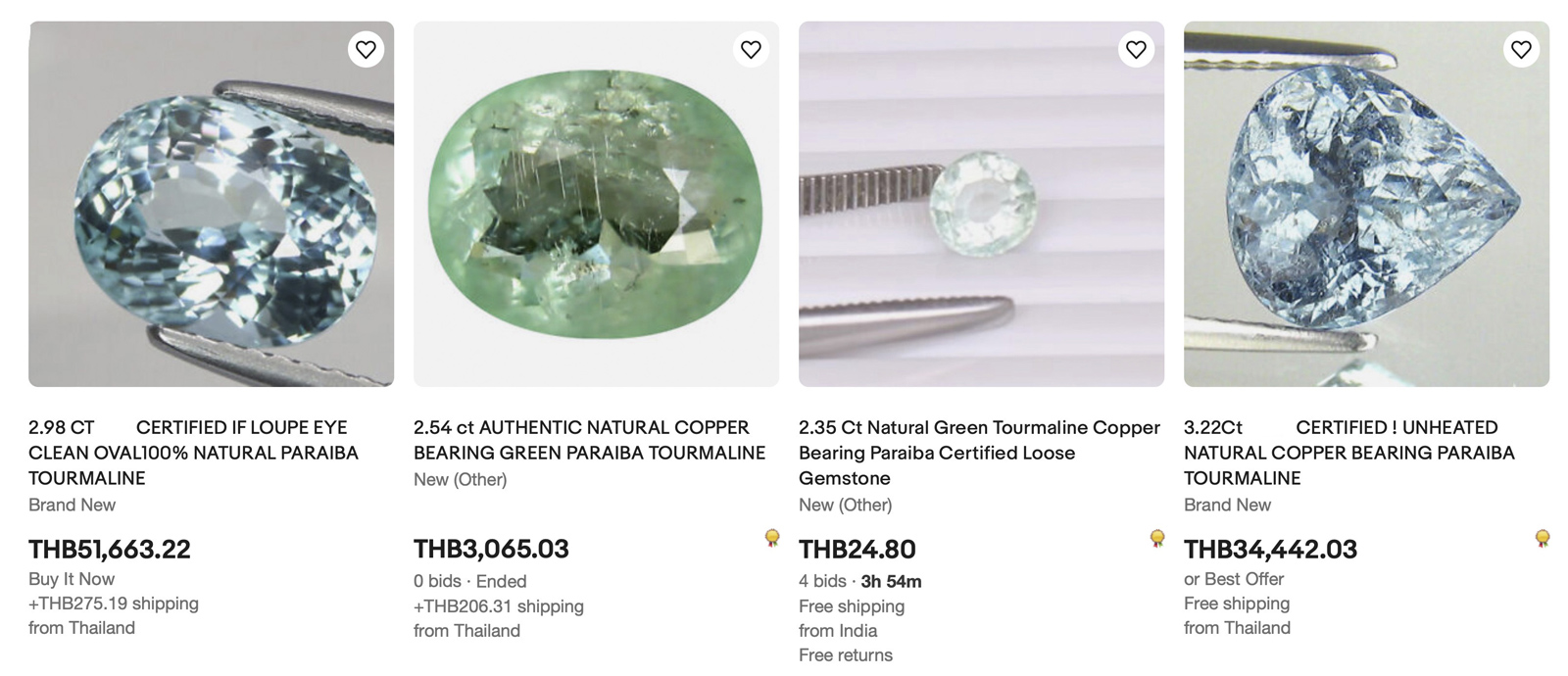 Figure 2. Fleabay Fun
Figure 2. Fleabay Fun
The laughs really begin when you look at gems listed on eBay. I did a quick search for “Paraíba tourmaline” and this group of gems between 2–3 ct came up on the first page. The prices range from less than a dollar to about $1500. If we assume that the above photos accurately represent the stones in question, each gem would probably comply with the Laboratory Manual Harmonization Committee (LMHC, 2023) specification for “Paraíba” tourmaline. But would anyone suggest with a straight face that these resemble what sent Heitor Dimas Barbosa off on his multi-year quest? Gem labs (with a big push from dealers) have widened the meaning of Paraíba tourmaline to such a degree that many are unrecognizable when compared to the original Brazilian stones. Photo: eBay
|
LMHC on Paraíba Tourmaline LMHC Information Sheet #6 – Paraiba Tourmaline: A paraiba tourmaline is a blue (electric blue, neon blue, violet blue), bluish green to greenish blue, green or yellowish green tourmaline, of medium-light to high saturation and tone (relative to this variety of tourmaline), mainly due to the presence of copper (Cu) and manganese (Mn) of whatever geographical origin.… The name of the tourmaline variety ‘paraiba’ is derived from the Brazilian locality Paraíba where this gemstone was first mined.
|
I GOT DEM OL’ COBALT BLUES AGAIN MAMA
Cobalt has been used as a dopant for synthetic spinel for a century or more and the neon blue stones are commonly found in costume jewelry or class rings. It was only in the early 1980s that gemologists identified cobalt in natural blue spinels from Sri Lanka (Shigley & Stockton, 1984). Later, Vietnam and Tanzania began producing cobalt-blue spinels (Figure 3).
At the same time, not all natural blue spinels contain cobalt. Once again, gemologists are being asked to decide what merits the term “cobalt blue.” Recent studies (Belley & Palke, 2021) have suggested that the blue-green to blue to violet spinels may contain multiple chromophores, including Co2+ (blue), both Fe2+ and Fe3+(green to blue), Cr3+ (red) and V3+ (orange). Mn2+ and/or Mn3+ may also play a role.
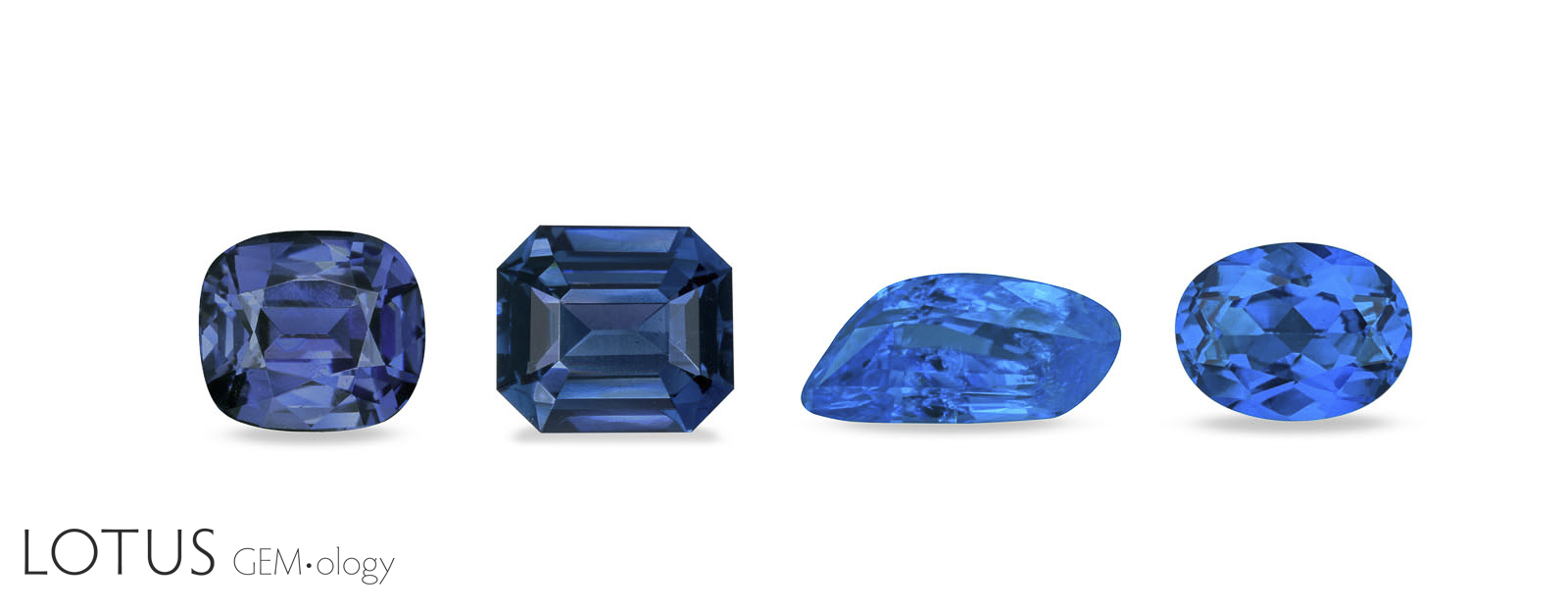 Figure 3. How Blue Can You Get?
Figure 3. How Blue Can You Get?
Four blue spinels, three natural and one synthetic (far right). All contain measurable cobalt using ICP-MS, but cobalt could not be detected in the two stones at left using Energy Dispersive X-Ray Fluorescence (ED-XRF). If labs and the trade decide that the term “cobalt blue” spinel should apply to all spinels that contain traces of cobalt, then a measurement technique must also be specified. Or should the labs and trade decide that only those that visually resemble the synthetic cobalt-blue spinel at right should qualify? Current information suggests that as few as ten parts per million (atomic) of cobalt might influence color (Ippolito et al., 2015). Determining the exact cobalt level is beyond the detection limits of instruments in all but a few gem labs around the world. Do we really need advanced chemical analysis on something that is at its foundation based on visual perception? Or should gemology focus on visual perception? Understandably, gemologists have traditionally focussed on "measurable criteria" as opposed to visual perception, which is far more complex to characterize. Thus the disconnect between what is "special" versus what is more akin to a blood test. Photos: Lotus Gemology
CHROMOPHORE CONFUSION
Separating gem varieties by chromophores is a prescription for problems, and this is not a recent phenomenon. Witness emerald. For over a century emerald was “defined” by gemologists as a beryl colored green by chromium, as opposed to a “green beryl.” Then it was discovered that many “emeralds” were actually colored by vanadium. Whoops!
And let’s not forget “chrome tourmaline,” which is also colored in part by vanadium. Whoops whoops!
The reality is that our current understanding of chromophores is imperfect. Thus, basing a variety definition on a chromophore means that said definition may not be “evergreen” (pardon the pun), but would change as our knowledge changes. The stone hasn’t changed, just the definition.
ALL SHOOK UP
To further complicate matters, the “color” of colored gemstones often results from different mixtures of chromophores and our understanding of these mixtures changes literally as I pen these words.
Even given a single chromophore, color will vary because it is created by selective absorption, and absorption is a function not just of chromophore concentration, but also one of path length. This is why it is not just difficult, but – going out on a limb here – incredibly incautious – to define a gem variety based on a percentage of any given chromophore.
Consider this. If you cut a 10 mm cube of synthetic ruby and a 20 mm cube of synthetic ruby from the same boule, the 20 mm cube will have twice the color as the 10 mm cube, even though they have the same percentage of the chromium chromophore, because the light path is twice as long (Figure 4).
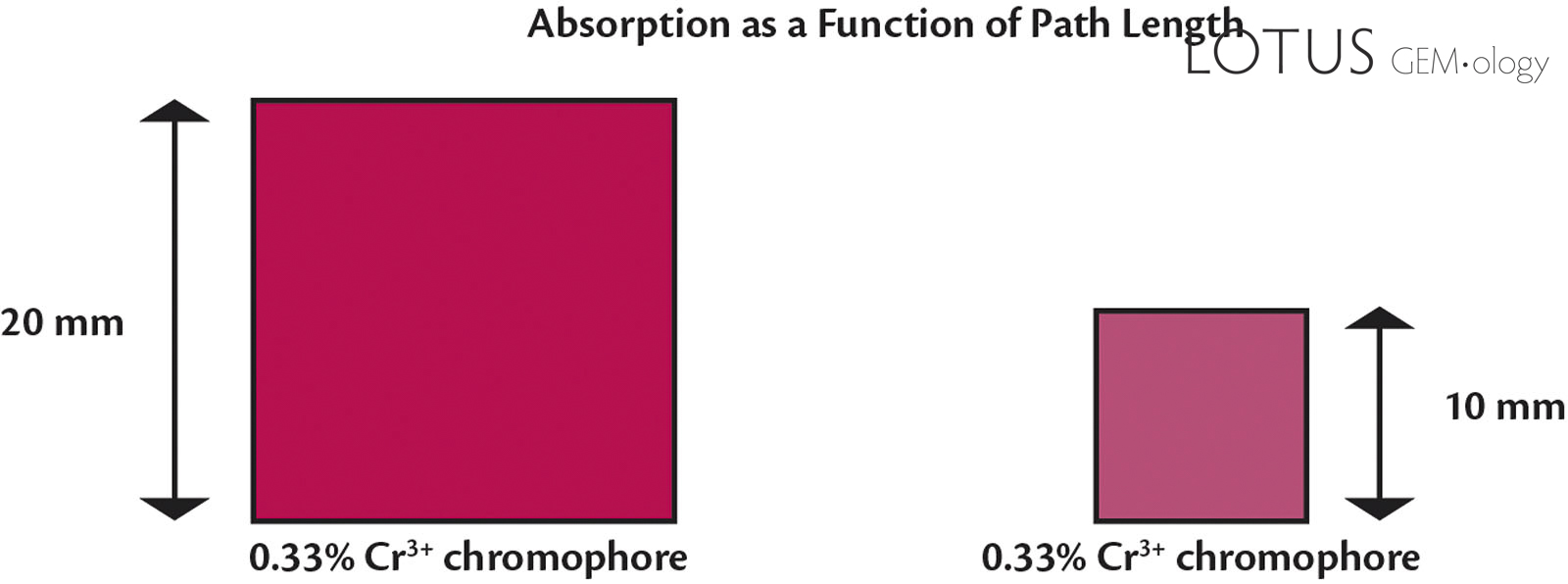 Figure 4. Given two cubes of synthetic ruby cut from the same boule where the Cr3+ chromophore is present at a level of 0.33% a 20 mm cube will have twice the color of a 10 mm cube, because the path length (and thus absorption) is double. This clearly demonstrates why the color appearance of gemstones cannot be defined simply by reference to measured chromophore concentrations. Illustration: Richard W. Hughes/Lotus Gemology
Figure 4. Given two cubes of synthetic ruby cut from the same boule where the Cr3+ chromophore is present at a level of 0.33% a 20 mm cube will have twice the color of a 10 mm cube, because the path length (and thus absorption) is double. This clearly demonstrates why the color appearance of gemstones cannot be defined simply by reference to measured chromophore concentrations. Illustration: Richard W. Hughes/Lotus Gemology
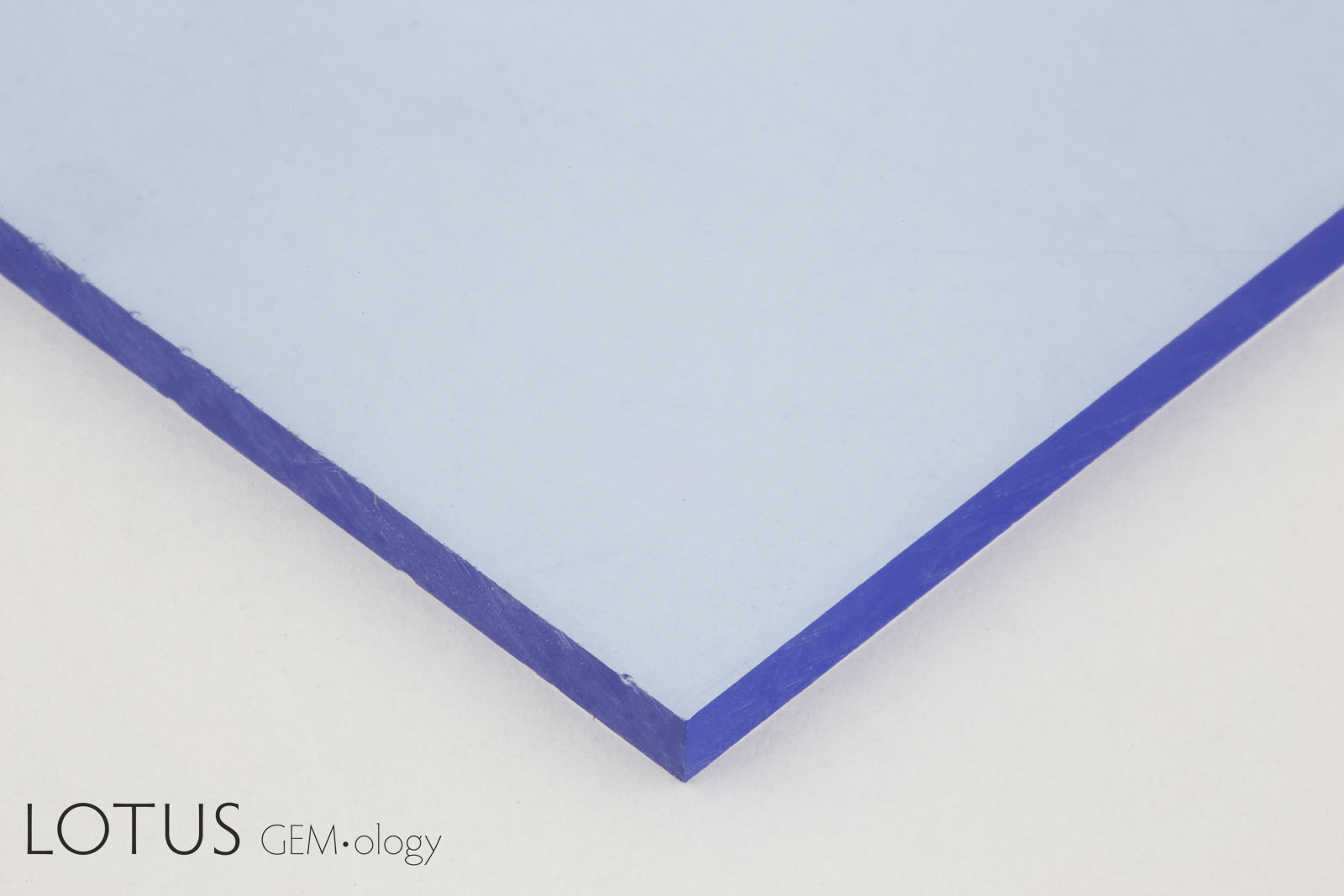 Figure 5. One of the easiest ways of understanding the relationship of path length to absorbance is to simply look at a colored plate. Through the broad side, there is little color visible, but the edges are deeply colored. This is because the path length of light traveling through the plate’s edges is a hundred or more times longer than that traveling perpendicular to that direction. Photo: Lotus Gemology
Figure 5. One of the easiest ways of understanding the relationship of path length to absorbance is to simply look at a colored plate. Through the broad side, there is little color visible, but the edges are deeply colored. This is because the path length of light traveling through the plate’s edges is a hundred or more times longer than that traveling perpendicular to that direction. Photo: Lotus Gemology 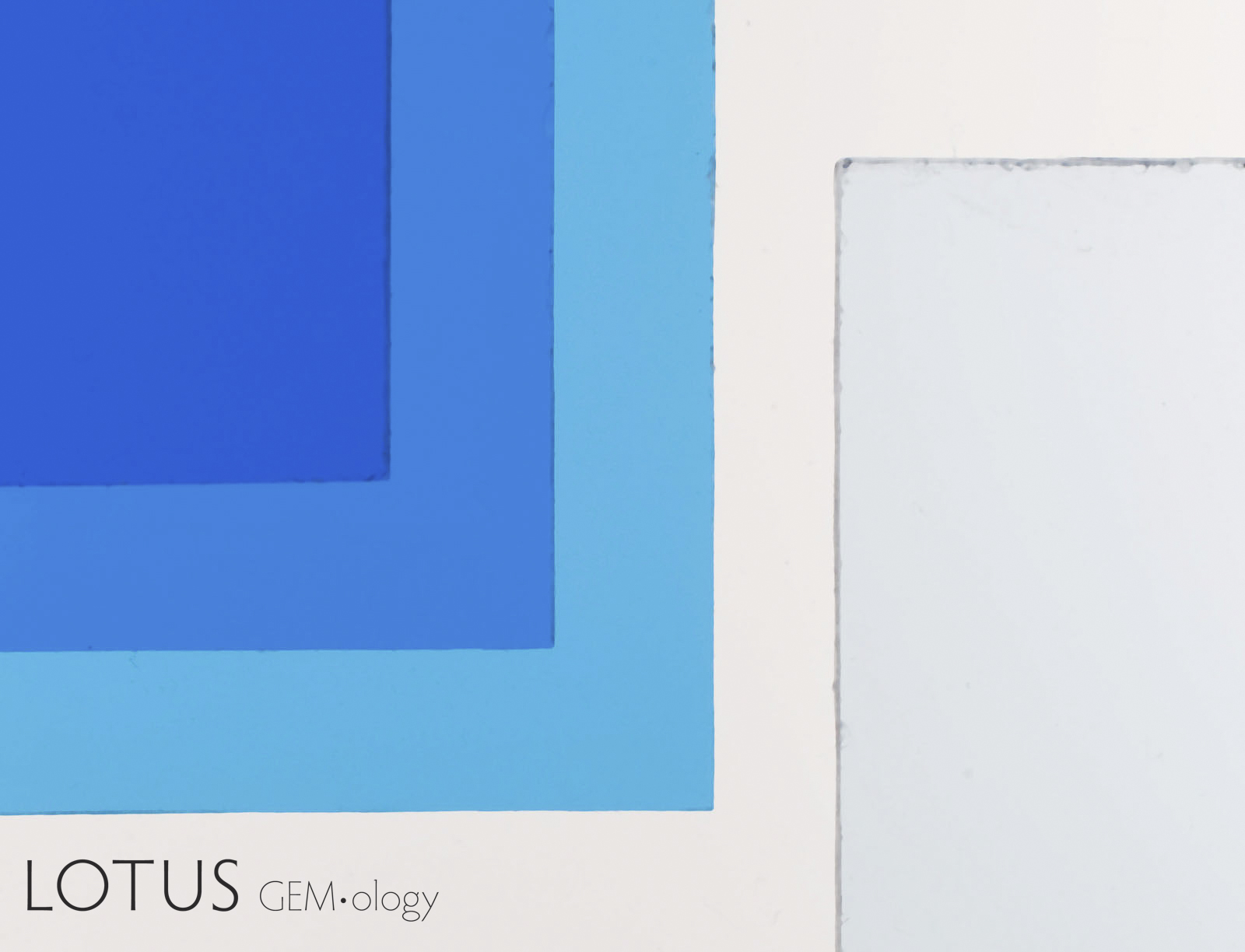 Figure 6. At left, three pieces of blue plastic laid on top of a white light source. Each piece is cut from the same sheet and thus has equal levels of the same cobalt chromophore, yet we can see a clear change in color as they are stacked on top of one another. This vividly illustrates how differences in path length can produce profound changes in color. If these were “cobalt” blue spinels, which would qualify? At right, an even lighter piece of blue plastic colored by the same cobalt chromophore. Would this qualify? Photo: Richard W. Hughes/Lotus Gemology
Figure 6. At left, three pieces of blue plastic laid on top of a white light source. Each piece is cut from the same sheet and thus has equal levels of the same cobalt chromophore, yet we can see a clear change in color as they are stacked on top of one another. This vividly illustrates how differences in path length can produce profound changes in color. If these were “cobalt” blue spinels, which would qualify? At right, an even lighter piece of blue plastic colored by the same cobalt chromophore. Would this qualify? Photo: Richard W. Hughes/Lotus Gemology
KODACHROME
Where did terms like “chrome green” or “cobalt blue” come from? Chrome means color, and chromophores are single elements or combinations that result in absorption in the visible region and thus produce color. Phrases like “chrome green” and “cobalt blue” have nothing to do with gems. These words probably came about as humans refined their knowledge of chemistry for creating pigments, dyes, and particularly, the doping of glasses with different elements. Only later did those terms come to be applied to gems that incorporated the same chromophores.
WHERE’S THE BEEF?
Today’s trade effectively demands that labs engage in speculative descriptions of the color of gems. They do this with their wallets, showering submissions on labs that use loose color descriptions, while not submitting gems to those that use narrower definitions (unless their customers demand otherwise). This process has completely upended the gem lab business. Formerly labs were only involved in identifying the type of gem, whether it is natural or man-made, and any treatments that might have been applied. Today, gem labs are being asked to identify where gems came from (a process that frequently involves significant amounts of speculation), and on top of that, provide ill-defined “color type” descriptions like “pigeon’s blood” or “padparadscha.”
The result is a corruption of the entire gem testing process, one that favors labs who will give clients what they want, rather than being a neutral umpire calling balls and strikes. It’s genius, really. When every lab sets their own “standards,” no one can be proven wrong because there effectively are no standards.
This is a race to a deep ocean bottom, as pointed out by Gemworld’s Stuart Robertson. In 2015, Robertson surveyed over 500 rubies listed on the Polygon gem trading network (Robertson, 2023, pers. comm.). Over 90% were found to have lab reports stating the stones had a “pigeon’s blood” color. Not unlike the dilution of "Paraíba" tourmaline, the Kobe beef of ruby red purity now includes more gristle than streetside meatballs.
 Figure 9. Slide from a 2017 Gemworld presentation discussing their 2015 research project on the pigeon’s blood color type.
Figure 9. Slide from a 2017 Gemworld presentation discussing their 2015 research project on the pigeon’s blood color type.
The gem trade faced a similar situation in the early 20th century. With virtually all diamonds being marketed as “blue-white,” the term became meaningless. This forced the US Federal Trade Commission in 1938 to outlaw the term as an “unfair trade practice.” Their ruling read:
§ 23.14 It is unfair or deceptive to use the term “blue white” or any representation of similar meaning to describe any diamond that under normal, north daylight or its equivalent shows any color or any trace of any color other than blue or bluish.
Federal Trade Commission
https://www.govinfo.gov/content/pkg/CFR-2011-title16-vol1/pdf/CFR-2011-title16-vol1-sec23-11.pdf
If things continue along a similar trajectory, could we see terms like “pigeon’s blood” and “royal blue” banned?
A FEW MORE WORDS ON COLOR TYPES
One of the largest areas of disagreement between gem traders and labs is in regard to “color types,” e.g. padparadscha, pigeon’s blood, royal blue, cobalt blue, etc. These terms have become wildly popular among dealers, but in my discussions with other gemologists, it is clear that no one – dealers, jewelers, or gemologists – can produce any sort of consistency.
This should come as no surprise when you consider the following differences between diamonds and colored stones:
Diamonds…
- Virtually no body color, and thus no color zoning.
- Virtually no eye-visible inclusions.
- No pleochroism.
- Symmetrical cutting.
- Ability to create body color master sets where the masters are the same size, shape and cut as the stone being tested.
In contrast, colored stones…
- May display considerable pleochroism.
- Often show color zoning that significantly affects the appearance.
- Often show eye-visible inclusions and differences in texture that affect appearance.
- Often show varying degrees of metamerism, where the color appearance changes under different light sources. Even if a single standard light source is agreed upon and used, it will not match the natural daylight used by dealers.
- Often are not symmetrically cut. As the gem’s price goes up, the symmetry usually goes down because cutters struggle to save weight.
- Even when symmetrically cut, faceted colored gemstones do not display a single uniform color. Instead, they show a three-dimensional mosaic of colors that changes when the stone, eye or light source moves. Color variations occur even across a single facet (Figure 10).
![]() Figure 10. Pick a Color, Any Color…
Figure 10. Pick a Color, Any Color…
Faceted gemstones are not a single “color,” but a three-dimensional mosaics of colors that change when the eyes, gem, or light moves. To help visualize this, the author has pixelated the gem at right to reduce the actual number of colors: So, what “color” is it? Photo: Lotus Gemology
WRESTLING THE PIG
Gemologists utilize different color atlases as guides to describe color for colored gems. These include GemGuide’s World of Color, AGL’s ColorCodex, the Munsell Book of Color and many others (Figure 11). Each of these systems can only provide the crudest frame of reference, for the simple reason that they all deal with color as a single monochromatic image. While AGL’s ColorCodex uses three-dimensional stamping of foil samples and the GemGuide’s World of Color uses a similar faceted overlay to mimic the appearance of faceted gems, none of these systems really resemble what we see in faceted gems. This is because faceted colored gems are not a single color (Figure 10). Most importantly, none of these devices can reproduce the vast universe of hues, intensities, shades and tones that colored gems represent (Figure 12).
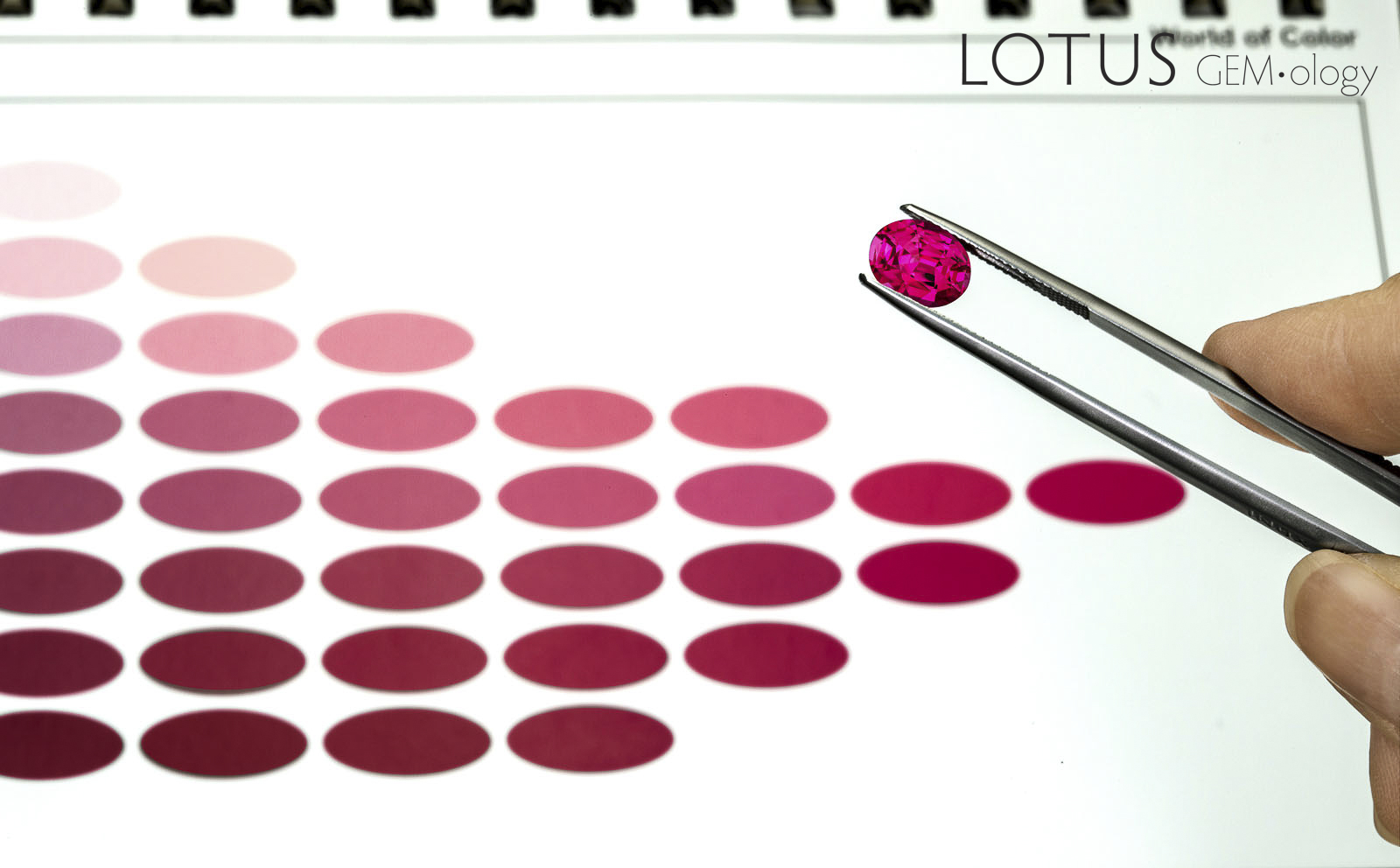 Figure 11. Where’s That Confounded Bridge?
Figure 11. Where’s That Confounded Bridge?
Laboratories utilize a variety of color atlases (top) to assist in specifying the color of gems, such as Gemworld’s World of Color (above). As good as these resources are, none can even come close to the visual appearance of a faceted colored gemstone because they fail to address any of the problems described in this article. This includes the most important – faceted gems are not a single uniform color. Some labs also assemble master stone sets. The problem is that such sets break virtually every rule developed for diamond grading masters. Colored stone master sets generally differ significantly in size, shape, proportions and cutting style from the gems they are compared to. If such conditions are considered vital for accurate diamond color grading, why not for colored stones? The simple answer is that labs would quickly go broke trying to produce accurate colored stone master sets. The variety of gems and colors is simply too vast – a bridge too far. Photos: Wimon Manorotkul/Lotus Gemology
ARE COLOR TYPES QUALITY GRADES?
Labs are being asked to apply quality terms to gems while under their breath quietly mouthing the idea that this is not quality analysis. To quote Stuart Robertson: “[Color types] are implied quality ranks masquerading as color descriptions.” The result is the findings on lab reports are more opinion than fact. We have now reached the point where lab reports begin to resemble Facebook posts more than any form of measurable science.
Color types are an invitation to conflict because there is no systematic approach that works for describing the appearance of faceted gems. If dealers keep demanding that labs put these terms on their reports, they should be prepared to deal with vast differences in opinion, not just from lab to lab, but even from gemologists within the same lab. I speak from experience. This is the greatest source of conflict within our lab, and I suffer doubly because I really can’t fire my wife or daughter when they disagree with my color calls, which they frequently do!
We all need to recognize that transparent faceted colored gemstones are extremely complex objects whose color appearance is affected to varying degrees by many different factors. Describing them with a degree of precision is currently impossible. If we want consistency, all we can do is speak in broad generalities.
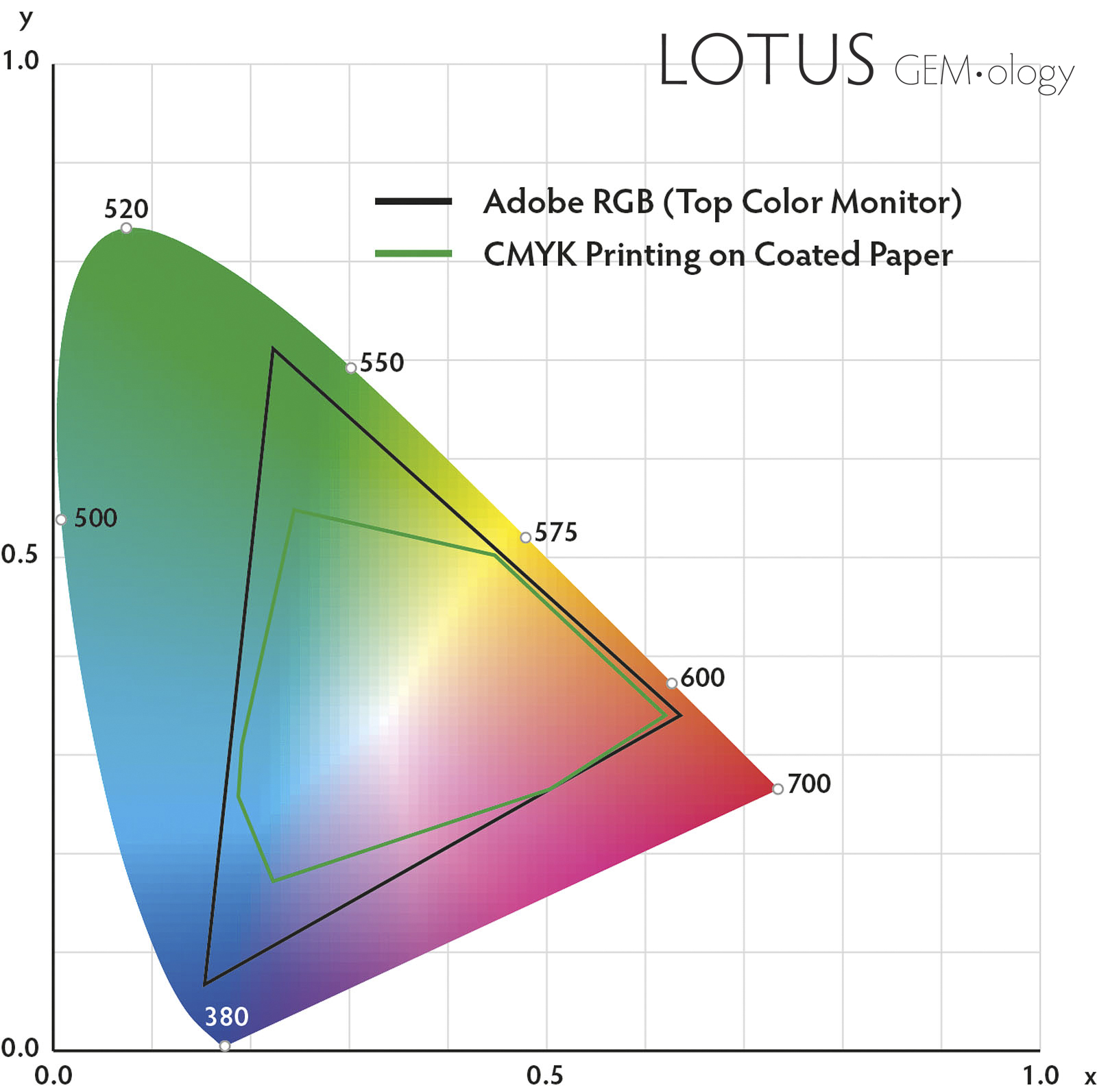 Figure 12. The C.I.E. chromaticity diagram above is used to specify the exact position of all colors visible to the human eye. Note that a computer monitor (represented by Adobe RGB, the black triangle) can only display some of these colors, while the colors that can be printed using the standard CMYK printing process (the green polygon) are even further restricted. Since the colors of the most expensive colored gems are often outside both of these “gamuts,” judgment must be made by personal examination, rather than via computer displays or printed images. Illustration: Richard Hughes/Lotus Gemology
Figure 12. The C.I.E. chromaticity diagram above is used to specify the exact position of all colors visible to the human eye. Note that a computer monitor (represented by Adobe RGB, the black triangle) can only display some of these colors, while the colors that can be printed using the standard CMYK printing process (the green polygon) are even further restricted. Since the colors of the most expensive colored gems are often outside both of these “gamuts,” judgment must be made by personal examination, rather than via computer displays or printed images. Illustration: Richard Hughes/Lotus Gemology
ISN’T THAT SPECIAL?
The above terms I’ve highlighted – from cobalt blue spinel, through pigeon’s blood to Paraíba – have all come about because something was discovered that was “special,” something with an appearance that significantly differed from most other gems of the same type. The moment we try to apply chemistry tests to determine what is special, we multiply the complexity by a factor of ten times or more, involving multiple chromophores, calculating chromophore concentrations and interactions, absorption coefficients, light path lengths and so much else. And to what end? To take us back to the central question: Is the visual appearance of this gem special and, if so, in what way?
What makes a gem “special?” All of us in this industry – dealers, gemologists, miners, jewelers, cutters – should be asking this question. Is it a few bits of ink on a lab report or digits in the ether that represent the thoughts of others? Or is it how it makes you feel when you first view it?
TASTE TEST
Do not fear mistakes – there are none.
Miles Davis
This subject of what is “beautiful” is not something restricted to gemology but is also a hot topic in psychology. Current studies suggest that when humans are shown a selection of different paintings, each reacts differently. Our reactions depend on our individual genetic makeup and previous experience. And yet the ability to be emotionally moved by art is universal (Vessel et al., 2012).
We all react, but in different ways. The common thread is that our emotions and judgement are tied to our past experiences, our story, which eventually becomes our history. We each have different “tastes.” Taste means that we don’t all like the same things. Taste means that there is no universal right (or wrong). Taste means that the engine of universal color grading blows up at the starting line. Taste means that “color types” for colored stones are artificial taste edifices. They are effectively “taste” prejudices imposed on us by others.
In 1980, I began teaching gemology. Each morning, my colleagues and I would examine goods purchased by international buyers the previous day. I was surprised to learn that blue sapphires that looked too dark to my "inexperienced" eye were the gems that fetched the highest prices. And so my “taste” changed. But many years later, I realized that my original “taste” was what I liked the best. As Miles Davis once said: “Sometimes you need to play a long time to be able to play like yourself.”
These are the things I want to know when I buy a gem and they are non-negotiable:
- What is it (in normal gemological parlance; spinel, corundum, beryl, etc.)?
- Is it real or man-made?
- Has anything been done to it other than cutting and polishing?
All of these are facts based on evidence, and if labs are competent, reports should almost always arrive at the same conclusions. This is certainly not the case for color types and origins, where, if you get reports from different labs on the same stone, you frequently end up with differing opinions.
THE DECIDER
Grown-ups never understand anything for themselves,
and it is tiresome for children to be always and forever explaining things to them.
Antoine de Saint-Exupéry [1900–1944] – The Little Prince
Should dealers and auction houses define what is special, or should gem labs – or both? Or should we leave it to children to make those decisions?
I know that if I throw a piece of cobalt-doped synthetic spinel into a parcel of natural blue spinels, a child will pick it out 100 times out of 100. In the same way, if I take a piece of Brazilian Paraíba tourmaline and throw it into a parcel of ordinary green tourmalines, the child will pick it out every single time. But what gemologists are now being asked to do is referee the color calls on thousands of specimens that no child would ever pick out as being special.
The success of diamond grading has led customers to expect the same for colored stones. But diamonds and colored stones are so different. As a Geneva dealer told me thirty years ago: “My ten-year-old son can sell diamonds. It’s just trading paper.”
Colored stones are far more complex. Perhaps we need to treat them like fine art. Would you submit a painting to a lab for anything other than to determine if it’s genuine or not? Would you expect a lab to weigh in on the quality of the art?
There is no “system” of quality analysis for fine art because of the obvious – it's a personal choice. “Special” means something different to each of us. In truth, there is no finest color; that is a personal preference for each of us.
I’ll close with this. Decades ago, Brazilian Heitor Dimas Barbosa noticed something special – vividly colored neon fragments of tourmaline in a pegmatite ore. So special that he spent years trying locate the place from which they came. I do not know the exact words he first used when he finally found the mother lode but am certain they did not include: “Minha Nossa! Olha esse cobre!”

POSTSCRIPT
So what about that Pantone thing? Pantone is a method of specifying what printers call "spot colors" for printing, where the client absolutely needs colors to match and doesn’t want to leave the decision to an operator adjusting CMYK ink values on the press. Think Coca Cola, where the red color of the can and the box need to match exactly. So you choose a “spot” color that has a predetermined mixture of inks and that is printed as a fifth color. Pantone has nothing to do with gems and Pantone swatch books are not laid out by the hue, tone and saturation systems used by color scientists and, as such, are thus poor references for comparison with gems.
References & further reading
- Belley, P.M. and Palke, A.C. (2021) Purple gem spinel from Vietnam and Afghanistan: Comparison of trace element chemistry, cause of color, and inclusions. Gems & Gemology, Vol. 57, No. 3, Fall, pp. 228–238.
- Fritsch E., Shigley J.E., Rossman G.R., Mercer M.E., Muhlmeister S.M., Moon M. (1990) Gem-quality cuprian-elbaite tourmalines from São José da Batalha, Paraíba, Brazil. Gems & Gemology, Vol. 26, No. 3, Fall, pp. 189–205.
- Gübelin, E.J. and Schmetzer, K. (1982) Gemstones with the alexandrite effect. Gems & Gemology, Vol. 18, No. 4, Winter, pp. 197–203.
- Ippolito, V, d’, Andreozzi, G.B., Hålenius, U., Skogby, H., Hametner, K. and Günther, D. (2015) Color mechanisms in spinel: Cobalt and iron interplay for the blue color. Physics and Chemistry of Minerals, Vol. 42, pp. 431–439.
- Koivula, J.I. and Kammerling, R.C. (1990a) Gem News: Treated Paraíba tourmalines. Gems & Gemology, Vol. 26, No. 1, Spring, pp. 103–104.
- Koivula, J.I. and Kammerling, R.C. (1990b) Gem News: The discovery of the Paraiba tourmaline mine. Gems & Gemology, Vol. 26, No. 2, Summer, pp. 164–165.
- LMHC (2023) LMHC Information Sheet #6: Paraiba Tourmaline. Version 8, February, 2 pp.
- Shigley, J.E. and Stockton, C.M. (1984) ‘Cobalt-blue’ gem spinels. Gems & Gemology, Vol. 20, No. 1, pp. 34–41.
- Vessel, E., Starr, G.G. and Rubin, N. (2012) The brain on art: Intense aesthetic experience activates the default mode network. Frontiers in Human Neuroscience, Vol. 6, Article 66, 17 pp.
Acknowledgements
The author would like to thank Gemworld's Stuart Robertson and Brecken Branstrator for proposing this article and William Larson, E. Billie Hughes, Wimon Manorotkul and Kaylan Khourie for a careful reading of the manuscript. Last, thanks to Rui Galopim de Carvalhõ for help with Portuguese.
About the author
Richard W. Hughes is one of the world’s foremost experts on ruby and sapphire. The author of several books and over 170 articles, his writings and photographs have appeared in a diverse range of publications, and he has received numerous industry awards. Co-winner of the 2004 Edward J. Gübelin Most Valuable Article Award from Gems & Gemology magazine, the following year he was awarded a Richard T. Liddicoat Journalism Award from the American Gem Society. In 2010, he received the Antonio C. Bonanno Award for Excellence in Gemology from the Accredited Gemologists Association. The Association Française de Gemmologie (AFG) in 2013 named Richard as one of the Fifty most important figures that have shaped the history of gems since antiquity. In 2016, Richard was awarded a visiting professorship at Shanghai's Tongji University. 2017 saw the publication of Richard and his wife and daughter's Ruby & Sapphire • A Gemologist's Guide, arguably the most complete book ever published on a single gem species and the culmination of nearly four decades of work in gemology. In 2018, Richard was named Photographer of the Year by the Gem-A, recognizing his photo of a jade-trading market in China, while in 2020, he was elected to the board of directors of the Accredited Gemologists Association and was appointed to the editorial review board of Gems & Gemology and The Australian Gemmologist magazine. Richard's latest book, Jade • A Gemologist's Guide, was published in 2022.
Notes
An abbreviated version of this was publshed in the GemGuide, 2023, May/June, pp. 1–7.

